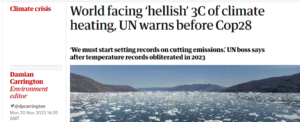Fossil fuel producers expand production while promising to reduce emissions,. They plan to keep mining and pumping carbon past the year 2050. The “2023 Production Gap Report” shows brain-breaking disconnects in word and deed. Co-Lead Author Michael Lazarus explains. Then “Record-high CO2 emissions from boreal fires in 2021”. Wildfires of 2023 were worse. Dr. Philippe Ciais, Associate Director of a French climate lab tells us where all that burned carbon goes – heating the planet.
Welcome to Radio Ecoshock. I’m Alex Smith.
Listen to/download this Radio Ecoshock show in CD Quality (57 MB) or Lo-Fi (14 MB)

Freaky heat waves continue in late 2023. The late cooker in the Eastern Mediterranean moved on. Now, well before the peak of summer in the Southern Hemisphere, several countries are smashing heat records. Brand new nighttime highs ever recorded in South America happened last week. The highest temperature ever recorded in South America was this week. You only heard about it because Taylor Swift had to cancel a concert in Rio de Janeiro as fans died in the heat.
As Matthew Todd [@MrMatthewTodd] Tweet/X’d on November 14: “BRAZIL GRIPPED BY ‘UNBEARABLE, UNPRECEDENTED’ HEATWAVE. Red alerts have been issued for almost 3,000 towns and cities across Brazil, which have been experiencing an unprecedented heatwave. Records have been broken in areas including the city Rio de Janeiro – where temperatures felt as high as 52.5C [126.5 F].
More than a hundred million people have been affected by the heat, which is expected to last until at least Friday.”
The BBC has a news report: “Brazil: Health warnings as country gripped by ‘unbearable’ heatwave”. Find a link in my blog.
According to ABC News, it was even worse. They say: “The heat index – a combination of temperature and humidity – hit 58.5 degrees Celsius (137 Fahrenheit) Tuesday morning in Rio, the highest index ever recorded there.” The actual temperature was a record 42.5°C with high humidity making it feel like 58.5°C. I’ve been to Rio. It’s on the sea. It is still Spring there. Anyone without air conditioning is afraid for their lives. The majority of people do not have air conditioning.
That is where we start as America, Russia, Saudi Arabia, Canada, everybody with a coal mine or a well is investing heavy profits into far more production. Governments of those countries not only approve, they subsidize it, brag about it, militarize it and generally enable a very dangerous climate shift. Whatever else you hear from the Abu Dhabi COP28 Climate Summit, those encouraging green words – in the real world big money invests in more coal, more oil, more natural gas, more pipelines, more gas ships, more ports, more, more, more greenhouse gases to cook the planet. Somehow, that must never happen. Here is the story.
========================================
MICHAEL LAZARUS:
THE 2023 PRODUCTION GAP REPORT
’Governments are literally doubling down on fossil fuel production; that spells double trouble for people and planet.” – Antonio Guterres, Secretary General of the United Nations.
“The production and use of fossil fuels have reached record high levels. If global carbon dioxide (CO2) emissions — of which close to 90% stem from fossil fuels — continue at the current pace, the world could exceed the remaining emissions budget compatible with a 50% chance of limiting long-term warming to 1.5°C by 2030.” – 2023 Production Gap Report
When crushing heat, fires, and storms wreck the planet, it is good to have a plan. The top 20 energy producing countries have a plan: make it worse, much worse. Forget the green chatter from politicians and conferences. You won’t believe what your country is doing – the damaged future all the coal miners, oil pumpers and gas frackers are building for you and yours. Burn it till we drop kids, that’s the plan.
Who says so? The United Nations and the Stockholm Institute are part of a group publishing the “2023 Production Gap Report”. It is simple: here is what countries promised to reduce emissions. Here are new energy projects approved by those same nations. New production is twice what a safe climate can bear. Michael Lazarus is US Center Director at Stockholm Environment Institute. He is one of two Lead Authors of the new report released in November.

Listen to/download my interview with Michael Lazarus in CD Quality or Lo-Fi
This is the report which is gathering world press under headlines like: “World facing ‘hellish’ 3C of climate heating, UN warns before Cop28”. Find the United Nations Environment Program “Emissions Gap Report” here.

EXECUTIVE SUMMARY:
Michael co-authored an earlier study showing the huge gap between production plans and climate targets, in 2019.
VIDEOS FOR THE LAUNCH OF THE 2023 PRODUCTION GAP REPORT
SHORT INTRO
Production Gap Report 2023 2 min
LAUNCH EVENT 1 hr 16 min
JUST 20 COUNTRIES
The report analyzes 20 major producer countries. Altogether, these countries account for 82% of production and 73% of consumption of the world’s fossil fuel supply.
AMERICA
From the 2023 Production Gap report:
“The US Energy Information Administration (EIA) forecasts that oil production will reach and remain at record high levels of 19 [to] 21 [Million barrels per day] from 2024 to 2050, while gas production is projected to continually increase, reaching 1.2 trillion cubic meters in 2050...”
America is firmly committed to pushing global warming well beyond 2 degrees.
RUSSIA
It is pretty hard to get accurate figures out of the second largest fossil fuel producer, Russia. According to your report, Russia is the 6th largest coal exporter, the second largest oil exporter, and 2nd largest gas exporter at least from 2005-2021. Does the 2023 report include losses in the European market due to the invasion of Ukraine – or has Russia managed to keep expanding it’s gas exports anyway, just to different customers? Michael Lazarus discusses this in the interview. See my notes on China below.
The Production Gap report says:
“In March 2023, the President of the Russian Federation noted energy cooperation with China was expanding and that Russian gas exports to China will reach at least 98 billion cubic meters by 2030 (not including another 100 million tonnes of liquefied natural gas). They also stated that agreement had been reached on most of the parameters for a new pipeline across Mongolia with the capacity to export 50 billion cubic meters of Russian gas to China (President of the Russian Federation, 2023).”
The report finds the Russians plan expanding coal production and exports. They also say: “There is no public discussion indicating that the Government of the Russian Federation agencies or SOEs [State-Owned Enterprises] have considered the need or are planning to wind down fossil fuel production or consumption.” That is true of many of the top producing countries studied. No plan to stop climate catastrophe. None.
CHINA
China is one of the biggest fossil fuel customers. China is the largest importer of coal, bringing in more than half of global coal exports. The country is the sixth largest oil importer and 4th largest methane gas importer.
As the world’s largest economy and greenhouse polluter, China really matters to the climate all of us experience. They are a mixed bag. On one hand, China just approved 3 large new coal mines, but they stopped financing coal power stations overseas. China has more renewable energy installations, coming on faster, than any other country by far. And yet this UNEP report finds China provided “…more energy sector loans to public entities than any other lender in the world…” That tsunami of energy loans has decreased in the last two years. Most of it was involved with the “Belt and Road” project.
In addition to importing more Russian coal, Al Jazeera reported “China’s imports of Russian pipeline gas and liquefied natural gas in 2022 soared 2.6 times and 2.4 times” and “China’s imports of Russian crude oil spiked 8 percent in 2022, the equivalent of 1.72 million barrels per day” making Russia the second-biggest provider of oil for the Chinese economy.
Should we find hope or despair in China’s climate role? On November13th, the NGO Carbon Brief claimed “China’s emissions set to fall in 2024 after record growth in clean energy”. I doubt that. We will see.
Analysis: China’s emissions set to fall in 2024 after record growth in clean energy
CANADA
My own country Canada is so disappointing. The government claims they are climate leaders in the international community. Meanwhile they waste public money building a multi-billion dollar pipeline to export dirty tar sands oil. This green-talking government approved tons of new gas projects, and subsidizes producers. Worst of all, this report finds, quote “Canada has historically been one of the largest international public financiers of fossil fuels”. Canada is schizophrenic about climate change, but Canadians burn more fossil fuels per capita than most other people in the world, and are increasing net energy production and exports. This is no Green Democracy.
SAUDI ARABIA
Half the Gross Domestic Product of Saudi Arabia is based on oil and gas production. The Saudi’s are not an open information society. What did your team manage to find out about their plans for more oil and gas production?
Hiroko Tabuchi of the New York Times found Saudi Arabia has,: [an] “aggressive long-term strategy to keep the world hooked on oil for decades to come and remain the biggest supplier as rivals slip away.”
Again, the Saudi government promises to slash emissions – but only from their production fields, not from shipping their oil and gas overseas. Norway is doing the same: “look a green offshore oil platform” meaning the energy to run the well comes from renewables. That is the dribble of greenwashing while the fire hose of emissions from their products rolls on. It feels like a trick.
AUSTRALIA
Australia is the world’s 5th largest coal producer, and 7th largest national gas producer. They import oil.
What has Australia promised for 2030 emission reductions? Not much, and they are backtracking on even that little.
The Production Gap report found a 2022 government list of major projects which included “69 coal projects and 49 new oil and gas projects in the pipeline”. How are they going to reduce greenhouse gases by 43% by 2030, while championing the expansion of their coal and gas exports?
THE TRICK
Countries like Australia and Canada just claim emissions from the fossil fuels they burn at home, and never count massive emissions when their coal, gas, and oil are burned in Asia or any other country. Shouldn’t producers be held responsible for the climate damage they create and profit from?
Too often, governments push climate responsibility away from multinational coal, oil, and gas companies down toward the consumer. You and I should pay a carbon tax at the pump. But in most countries, fossil fuel companies pay hardly any taxes at all. In fact, they get billions in subsidies from governments.
The 2023 Production Gap report covers 20 top fossil fuel countries – but seldom points to private companies operating in this space. Exxon/Mobil, BP, Shell and the rest – they have the vast profits. Their Board of Directors approve new fossil mines and wells. They plan production into 2050 and beyond. These may need another report.
THE VERDICT: COGNITIVE DISSONANCE WITH FATAL IMPACTS
“In the field of psychology, cognitive dissonance is the perception of contradictory information and the mental toll of it.”.
I felt a heavy mental toll reading this Production Gap report. The greenwashing talk from climate conferences is hard enough. But the worst part: this confirms major governments and their fossil fuel partners definitely plan to accelerate greenhouse gases, right into the teeth of climate already more extreme than humanity ever witnessed. It is madness.
After reading this report, we are at a fork in the road, with at least two possibilities. All these new gas, oil, and coal projects go ahead pushing Earth past the 2 degree danger line in a decade or two. OR – these projects may be called back or abandoned as stranded assets. Pick your future.
Get your copy at productiongap.org
ALEX THINKS: I’m like a kid in a candy store with all this hard to find data and summaries in one place. There are literally tons of dirty little secrets in here – except they are not secret. It’s just they don’t get media coverage, nobody cares, and everyone wants THEIR country to keep on providing energy and making tons of money to support living standards – even as fires, storms, and floods put them out of house and home.
if you do hear the truth, that must be discounted immediately by minimizing, counter-facts, bright-siding and green-sounding language. The defenses for extreme climate damaging actions will be framed in terms of national security, threats to your way of life if not accomplished, and mind-breaking contradictions between promises and action. In fact, the dichotomy is so huge, the “production gap” problem becomes absurd, impossible to digest, impossible to think about.
The facts in this report are upsetting. There is nothing upsetting about the language in it. It does not include consequences. It just states what was promised versus what is happening.
A gang of wealthy humans, mostly men, are building a dystopian world – where our civilization has a 50% chance of surviving, and an unknown chance of dying off in a mass extinction of species. The super-wealthy intend to enrich themselves while doing it. They claim we are making them do it, billions of people will starve if they don’t, they are the responsible ones, carrying the known world into climate failure.
============================================
WILDFIRES AND CLIMATE CHANGE: PHILIPPE CIAIS
“Boreal fires, which typically account for 10% of global fire carbon dioxide emissions, contributed 23% in 2021, a new study reports.”
– Press Release March 2, 2023 in Science.
Listeners know I follow wild-fires. You do that when you live in fire country. My country Canada burned more than ever before, and that is saying a lot. Carbon, and black carbon, from those fires are enough to push more heating on the world. They also changed the albedo of the planet, reflection of Sun’s energy. Finally I found scientists asking that very question: how do the new extreme wildfires change the climate?
For decades we worried the burning Amazon could tip world climate. Closer to home, the great Boreal Forest across the planet’s far north is burning hard. Where is all that carbon going? Will it make global warming worse?
Our guest is co-author of the March 2023 paper “Record-high CO2 emissions from boreal fires in 2021”. Dr. Philippe Ciais is Associate Director of the “Laboratoire des Sciences du Climate et de l’Environnement”. That climate lab is located in the Institut Pierre Simon Laplace, a top-level research institute west of Versailles. Dr. Ciais is a physicist specializing in the global carbon cycle and climate change.

Listen to/download my interview with Pilippe Ciais in CD Quality or Lo-Fi
“Fire emissions from global forest ecosystems have been increasing since 2000, as have drought-driven extreme fires that emit vast amounts of CO2 over forests and peat-lands in short periods (6–8). Such extreme fires are projected to become more frequent and widespread in response to future climate change.”
– Paper “Record-high CO2 emissions from boreal fires in 2021”
It is strange that 2021 Boreal fires were so far out of the ordinary, a bigger change than any tropical fires this century – and yet we heard practically nothing about it. Only a decade or two ago, we were told not to worry about carbon from forest fires – because a similar amount would be taken back out of the atmosphere as vegetation grows back. Early climate models did not include carbon from wildfires. Governments still don’t count this big source of carbon in their emissions statistics, or in their promises for the Paris Climate Treaty. Now we know, especially in climate-charged mega fires, that “balance” is no longer true.
This paper says 80% of carbon released by fires is taken up by vegetation in subsequent growing seasons and only 20% remains in the atmosphere longer, adding to the warming burden. But is that still true when (a) never-before-seen huge fires may produce more CO2 than previous fires, or than can be absorbed by the natural systems, and (b) other climate factors like drought may change the landscape so the former rate of uptake does not happen? Dr. Ciais agrees these numbers could change in a warming world.
A fast look at anomalies in 2021 [Fig 2.] suggests that particular fire season was more heavily concentrated in Siberia than in Northern Canada. The year of 2023 seems the opposite. Do we know why the balance of fire might shift between continents and (b) should we fear a year of super-fire when both Siberia and northern North America are in record-setting mode in the same year?
OH …AND THE CANADIAN WILDFIRES
Canadian fossil fuel emissions (2021): 545 MtCO₂
Canadian wildfire emissions (typical year): 290 MtCO₂
Canadian wildfire in 2023 (CAMS estimate): 1,740 MtCO₂
This year's record-setting Canadian fires burned >3 times as much carbon as all of Canada's annual fossil fuel use.
— Dr. Robert Rohde (@RARohde) October 23, 2023
YOU MAY BE INTERESTED IN THIS CBC TV SHORT PIECE ON CANADIAN FIRE EMISSIONS IN 2023
How Canada’s record-breaking wildfires are intensifying climate change
PREVIOUS RADIO ECOSHOCK SHOWS ABOUT WILDFIRE AND CLIMATE
It Was The Hottest of Times
Posted on October 11, 2023,
Professor Justin Angle author of “This Is Wildfire: How to Protect Yourself, Your Home, and Your Community in the Age of Heat.”
Climate in a Fiery World
Posted on June 16, 2021
Global heat roundup + Harvard’s Dr. Loretta Mickley: how fiery this planet is. Do wildfires and those far-flung clouds of smoke heat or cool the planet?
On Fire Again
Posted on May 24, 2023
3 of my best interviews on wildfires: Mike Flannigan, Andrew Sullivan & David Bowman
=================================
NEW SCIENCE WITH ALEX SMITH
We have so many climate warnings lately, a person could do a daily climate program. We need a fully-funded professional 24 hour cable and Net channel reporting on the climate emergency. Instead of the latest gossip about Trump, Swift, or Cameron – the climate network would show those freak floods in Italian towns, burned out crops, and massive fires. What happened in Acapulco after that city was blown out by an instant Cat5 Hurricane? Is the North African heat wave adding to unrest? Did you know the Arctic has been overheated and loaded with abnormal amounts of methane? Talk to slum-dwellers in Rio during the feel-like 137 degrees Fahrenheit heat, 58.5 C reported by ABC News. Follow up for the death count. Tell it like it is.
Sure we can cover the good news about solar and wind, the bright ideas for a smart grid, the rare politicians pushing for survivable Earth. Instead of arresting anyone who protests climate catastrophe, labeling them terrorists – Climate TV can interview them. Could we hear actual green voices, unedited, unframed, instead of oil companies expressing their love for nature? Where are the climate crisis lines? Where is the emergency?
Here are a couple of story ideas.
1.5 WARMING COMES 8 YEARS EARLIER
You heard the Arctic is warming four times faster than the global average. When scientists at University College London plugged that into existing models: surprise! Those “don’t go past this” guide-rails of 1.5 degrees or 2 degrees C warming come eight years faster than we were told. With Arctic warming included, they found this planet will be consistently 1.5 degrees hotter than pre-industrial by the year 2031, and 2 degrees and climbing by 2050. Not 2040, but only 7 years away for temperatures when tipping points tip.
NO MORE LYING ABOUT THOSE EMISSIONS
Sort of good news: countries and industries can no longer lie about their greenhouse gas emissions. A new sensor aboard the International Space Station can identify point sources of greenhouse gas emissions. Where previous satellite measurements identified gas fields as sources of methane, this new technology can pinpoint who and where. In their “first 30 days of its operation, demonstrating its ability to track previously undetected emissions across the Middle East and Central Asia. The researchers identified 65 sources of carbon dioxide and methane emissions almost entirely from the oil and gas sector alone, as well as from landfills, wastewater treatment facilities, and power plants.” This news was published by the journal Science Advances.
Our Climate TV station could thrive on headlines like this in ScienceAlert: “Physicists Warn Earth Could Feasibly Descend Into Chaos”. Author Michelle Starr says “The impact of human activity on the Earth system could result in unpredictable chaos from which there is no return, physicists have calculated.” They worry about a “phase transition” found in many operations in this Universe. Oh those egg-head physicists – what would they know? Like that Einstein guy.
How about this one: “Projected Change in the Burden of Excess Cardiovascular Deaths Associated With Extreme Heat by Midcentury (2036–2065) in the Contiguous United States”. That was published October 30th. According to the American Heart Association, “Heat-Related Cardiovascular Deaths in the U.S. May More Than Double Within Decades.”
Extreme heat kills people with heart conditions. We don’t need to wait until the 2040’s. No doubt this is happening right now in South American heat waves. But now we know killer heat is coming to America.
Here is another worth an in-depth story: “Extreme weather is outpacing even the worst-case scenarios of our forecasting models.” That was published October 30th in The Conversation by Ravindra Jayaratne. On October 25, in 24 hours a Tropical Depression became Cat 5 Hurricane Otis slamming Acapulco. Sorry, I just can’t let that one go. NONE of the forecasting models predicted that. Not possible, and it is happening. I hope to talk with Ravindra Jayaratne in a couple of weeks.
The United Nations University issued a report “Interconnected Disaster Risks” – more on cascading tipping points in the Earth System. I have an interview with the author, conducted by UK film-maker Nick Breeze, coming up on this show.
Things are so upside down, even good news has a bad side. Take the great air pollution cleanup in China.
The Energy Policy Institute at the University of Chicago runs a service called “The Air Quality Life Index” or AQLI. They write:
“Despite significant increases in particulate pollution (PM2.5) in many regions of the world, global pollution has declined since 2013. That decline is due entirely to China’s success in steeply reducing pollution since declaring a “war against pollution” in 2014 after the country experienced some of its highest pollution levels. Swift policy actions led pollution in China to decline by 42.3 percent between 2013 and 2021, extending the average person’s life expectancy by 2.2 years if these reductions in pollution are sustained. Beijing province experienced the largest decline in pollution, dropping 56.2 percent in just eight years. The average person living there could expect to live 4.2 years longer… The Global Decline in Pollution in Recent Years is Due Entirely to China.”
That is great news for over a billion people in China. It is also part of the aerosol reduction that reveals our true level of warming. Without that cooling smog, and without the sulfur in ship emissions that Leon Simons and James Hansen point to – more of the actual warming hits the Earth. Like in Rio, or the next killer heat domes coming in 2024.
The World Meteorological Organization is finally waking up to the climate emergency. They say greenhouse gas emissions are still rising with no signs of stopping. I have an interview with a WMO spokesperson coming up. Stay tuned, as we record from a world in trouble, still hoping for a great awakening.
I’m Alex. Thank you for listening, and caring about our world.